
Get your FREE 30-day trial.
Please complete all fields.
As we stare into peak advertising season this December, it's time to take a quick break from the day-to-day task of running campaigns to think about what trends we have seen this year that will dominate 2017 storylines.
In our webinar on December 6th, we'll be covering a number of trends in more detail, along with how you should adapt your marketing today. Here are a few highlights to get you started:
Digital advertising will remain in a period of rapid growth, growing another 18% worldwide on top of 20% this year (eMarketer). However, that growth will not be evenly distributed. Instead, Facebook and Google will continue to consume more and more of the advertising industry, while digital advertising goes mobile-first.
You've probably already seen Mary Meeker's Kleiner Perkins Internet Trends Report in June that said 76% of the growth in digital advertising this year went to Facebook and Google. You might have seen that Brian Nowak at Morgan Stanley went further in April and said "in the first quarter of 2016, 85 cents of every new dollar spent in online advertising will go to Google or Facebook".
What's the latest? An analysis of the new IAB / PwC Internet Ad Revenue Report shows that 103% of the industry growth in the United States in the first half of 2016 came from Google and Facebook. Yes, that means that the rest of the digital advertising market actually shrank by 3%, despite double digit overall market growth.

As this growth trend accelerates, Google and Facebook will combine for 61% of all digital advertising revenue by 2018, up from "just" 35% in 2015.

We're seeing growth from Facebook and Google, but it's not those platforms overall -- the second big trend for 2017 is mobile advertising dollars running to catch up with mobile time spent.
According to Comscore, mobile now consumes two-thirds of all digital time spent in the United States, and its above 50% in every major market that eMarketer examined.

Mobile advertising spend is chasing after that time spent -- in 2015, eMarketer showed mobile advertising as just over half of all media spend in the United States, but that number will jump to 74% by 2018.

It's not a surprise Facebook and Google have stayed ahead of everyone else. The two platforms have focused on two key areas: personalizing advertising and those mobile trends we just examined.
Last month, Facebook announced that they have a billion mobile-only users -- not a billion users of the mobile app, but a billion people for whom the entire Facebook experience takes place on mobile. Google has invested its vast resources into mobile search, and in May 2015, more than 18 months ago, it said that "More Google searches take place on mobile devices than on computers in 10 countries including the US and Japan."
At the same time, both platforms have enabled more personalization of advertising than was ever possible before, especially using Facebook Custom Audiences and Google Customer Match.
What should you leverage these trends with your digital advertising? Watch our webinar to find out!